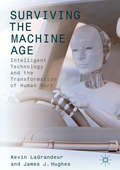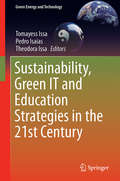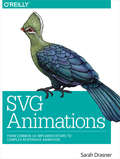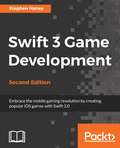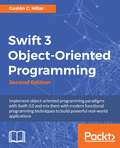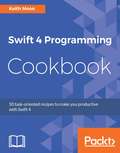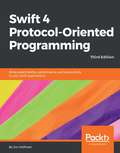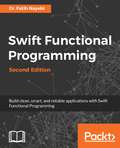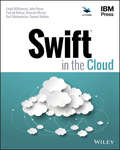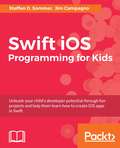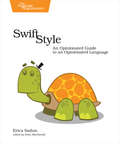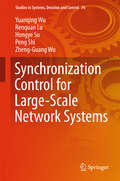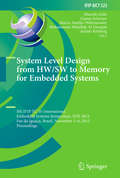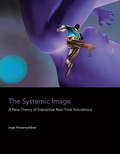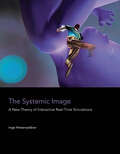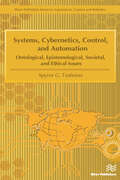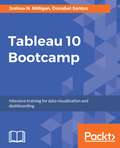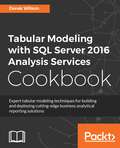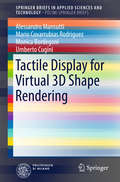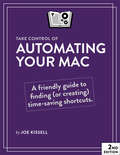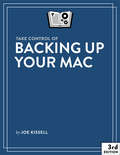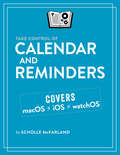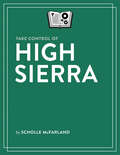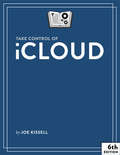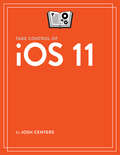- Table View
- List View
Surviving the Machine Age
by James J. Hughes Kevin LagrandeurThis book examines the current state of the technologically-caused unemployed, and attempts to answer the question of how to proceed into an era beyond technological unemployment. Beginning with an overview of the most salient issues, the experts collected in this work present their own novel visions of the future and offer suggestions for adapting to a more symbiotic economic relationship with AI. These suggestions include different modes of dealing with education, aging workers, government policies, and the machines themselves. Ultimately, they lay out a whole new approach to economics, one in which we learn to merge with and adapt to our increasingly intelligent creations.
Sustainability, Green IT and Education Strategies in the Twenty-first Century
by Tomayess Issa Pedro Isaias Theodora IssaThis work presents and discusses the latest approaches and strategies for implementing Sustainability and Green IT into higher education and business environments. Following the global financial crisis in 2007/2008, businesses began to struggle coping with the increased IT/IS cost and their environmental footprint. As a consequence, action by universities to incorporate sustainability and ‘Green IT’ as parts of their teaching and learning materials, acknowledging their importance for global and local businesses, is being increasingly implemented. The book addresses the cooperation and coordination between academics and practitioners needed in order to achieve the changes required to obtain sustainability.Intended for researchers, lecturers and post-graduate students, as well as professionals in the Information Society and ICT and education sectors, and policy makers.
SVG Animations: From Common UX Implementations to Complex Responsive Animation
by Sarah DrasnerSVG is extremely powerful, with its reduced HTTP requests and crispness on any display. It becomes increasingly more interesting as you explore its capabilities for responsive animation and performance boons. When you animate SVG, you must be aware of normal image traits like composition, color, implementation, and optimization. But when you animate, it increases the complexity of each of these factors exponentially.This practical book takes a deep dive into how you can to solve these problems with stability, performance, and creativity in mind.Learn how to make SVG cross-browser compatible, backwards compatible, optimized, and responsivePlan and debug animationMake a complex animation responsive, as many sites are responsiveProfile each animation technique in terms of performance so that you know what you're getting in to with each library or native technology
Swift 3 Game Development - Second Edition
by Stephen HaneyEmbrace the mobile gaming revolution by creating popular iOS games with Swift 3.0 About This Book • Create and design games for iPhone and iPad using SpriteKit and Swift 3.0 • Learn the core fundamentals of SpriteKit game development and mix and match techniques to customize your game • This step-by-step practical guide will teach you to build games from scratch using little-known tips and strategies for maximum fun Who This Book Is For If you wish to create and publish fun iOS games using Swift, then this book is for you. You should be familiar with basic programming concepts. However, no prior game development or Apple ecosystem experience is required. What You Will Learn • Deliver powerful graphics, physics, and sound in your game by using SpriteKit • Set up the scene using the new capabilities of the scene editor and custom classes • Maximize gameplay with little-known tips and strategies for fun and repeatable action • Make use of animations, graphics, and particles to polish your game • Understand the current mobile monetization landscape to choose the best option for your own situation • Integrate your game with Game Center so that your players can share their high scores and achievements • Publish your game to the App Store and enjoy people playing your games In Detail Swift is the perfect choice for game development. Developers are intrigued by Swift 3.0 and want to make use of new features to develop their best games yet. Packed with best practices and easy-to-use examples, this book leads you step by step through the development of your first Swift game. This book starts by introducing SpriteKit and Swift's new features that can be used for game development. After setting up your first Swift project, you will build your first custom class, learn how to draw and animate your game, and add physics simulations. Then, you will add the player character, NPCs, and powerups. To make your game more fun and engaging, you will learn how to set up scenes and backgrounds, build fun menus, and integrate with Apple Game Center to add leaderboards and achievements. You will then make your game stand out by adding animations when game objects collide, and incorporate proven techniques such as the advanced particle system and graphics. Finally, you will explore the various options available to start down the path towards monetization and publish your finished games to the App Store. By the end of this book, you will be able to create your own iOS games using Swift and SpriteKit. Style and approach This project-based guide is engaging with a visually-rich approach rather than a text-heavy approach. With every chapter containing practical examples, you will understand how Swift programming works and make the most of the new features in version 3.0.
Swift 3 Object Oriented Programming - Second Edition
by Gaston C. HillarThis book is for iOS and macOS developers who want to get a detailed practical understanding of object-oriented programming with the latest version of Swift: 3.0.
Swift 4 Programming Cookbook
by Keith MoonOver 50 recipes to help you quickly and efficiently build applications with Swift 4 and Xcode 9 About This Book • Write robust and efficient code and avoid common pitfalls using Swift 4 • Get a comprehensive coverage of the tools and techniques needed to create multi-platform apps with Swift 4 • Packed with easy-to-follow recipes, this book will help you develop code using the latest version of Swift Who This Book Is For If you are looking for a book to help you learn about the diverse features offered by Swift 4 along with tips and tricks to efficiently code and build applications, then this book is for you. Basic knowledge of Swift or general programming concepts will be beneficial. What You Will Learn • Explore basic to advanced concepts in Swift 4 Programming • Unleash advanced features of Apple's Xcode 9 IDE and Swift Playgrounds • Learn about the conditional statements, loops, and how to handle errors in Swift • Define flexible classes and structs using Generics, and learn about the advanced operators, and create custom operators • Explore functionalities outside of the standard libraries of Swift • Import your own custom functionality into Swift Playgrounds • Run Swift on Linux and investigate server-side programming with the server side framework Vapor In Detail Swift 4 is an exciting, multi-platform, general-purpose programming language. Being open source, modern and easy to use has made Swift one of the fastest growing programming languages. If you interested in exploring it, then this book is what you need. The book begins with an introduction to the basic building blocks of Swift 4, its syntax and the functionalities of Swift constructs. Then, introduces you to Apple's Xcode 9 IDE and Swift Playgrounds, which provide an ideal platform to write, execute, and debug the codes thus initiating your development process. Next, you'll learn to bundle variables into tuples, set order to your data with an array, store key-value pairs with dictionaries and you'll learn how to use the property observers. Later, explore the decision-making and control structures in Swift and learn how to handle errors in Swift 4. Then you'll, examine the advanced features of Swift, generics and operators, and then explore the functionalities outside of the standard library, provided by frameworks such as Foundation and UIKit. Also, you'll explore advanced features of Swift Playgrounds. At the end of the book, you'll learn server-side programming aspect of Swift 4 and see how to run Swift on Linux and then investigate Vapor, one of the most popular server-side frameworks for Swift. Style and approach Each recipe addresses a specific problem, with a detailed discussion that explains the solution and offers insight into how it works.
Swift 4 Protocol-Oriented Programming - Third Edition
by Jon HoffmanBuild fast and powerful applications by harnessing the power of protocol-oriented programming in Swift 4 About This Book • Leverage the power of protocol-oriented programming in your applications and learn from real-world use cases • Create a flexible code base with protocols and protocol extensions • Leverage the power of generics in Swift 4 to create very flexible frameworks Who This Book Is For This book is for Swift developers who want to learn and implement protocol-oriented programming in their real-world applications.. What You Will Learn • Understand the differences between object-oriented programming and protocol-oriented programming • Explore the different types that Swift offers and what pitfalls to avoid • Delve into generics and generic programming • Learn how to implement Copy-On-Write within your custom types • Implement several design patterns in a protocol-oriented way • Design applications by prioritizing the protocol first and the implementation types second In Detail Swift has become the number one language used in iOS and macOS development. The Swift standard library is developed using protocol-oriented programming techniques, generics, and first-class value semantics; therefore, every Swift developer should understand these powerful concepts and how to take advantage of them in their application design. This book will help you understand the differences between object-oriented programming and protocol-oriented programming. It will demonstrate how to work with protocol-oriented programming using real-world use cases. You will gain a solid knowledge of the various types that can be used in Swift and the differences between value and reference types. You will be taught how protocol-oriented programming techniques can be used to develop very flexible and easy-to-maintain code. By the end of the book, you will have a thorough understanding of protocol-oriented programming and how to utilize it to build powerful and practical applications. Style and approach This book is written for developers who learn best by working with code, so every concept discussed in this book is reinforced with real code examples.
Swift Functional Programming - Second Edition
by Fatih NayebiBring the power of functional programming to Swift to develop clean, smart, scalable and reliable applications. About This Book • Written for the latest version of Swift, this is a comprehensive guide that introduces iOS, Web and macOS developers to the all-new world of functional programming that has so far been alien to them • Get familiar with using functional programming alongside existing OOP techniques so you can get the best of both worlds and develop clean, robust, and scalable code • Develop a case study on example backend API with Swift and Vapor Framework and an iOS application with Functional Programming, Protocol-Oriented Programming, Functional Reactive Programming, and Object-Oriented Programming techniques Who This Book Is For Meant for a reader who knows object-oriented programming, has some experience with Objective-C/Swift programming languages and wants to further enhance his skills with functional programming techniques with Swift 3.x. What You Will Learn • Understand what functional programming is and why it matters • Understand custom operators, function composition, currying, recursion, and memoization • Explore algebraic data types, pattern matching, generics, associated type protocols, and type erasure • Get acquainted with higher-kinded types and higher-order functions using practical examples • Get familiar with functional and non-functional ways to deal with optionals • Make use of functional data structures such as semigroup, monoid, binary search tree, linked list, stack, and lazy list • Understand the importance of immutability, copy constructors, and lenses • Develop a backend API with Vapor • Create an iOS app by combining FP, OOP, FRP, and POP paradigms In Detail Swift is a multi-paradigm programming language enabling you to tackle different problems in various ways. Understanding each paradigm and knowing when and how to utilize and combine them can lead to a better code base. Functional programming (FP) is an important paradigm that empowers us with declarative development and makes applications more suitable for testing, as well as performant and elegant. This book aims to simplify the FP paradigms, making them easily understandable and usable, by showing you how to solve many of your day-to-day development problems using Swift FP. It starts with the basics of FP, and you will go through all the core concepts of Swift and the building blocks of FP. You will also go through important aspects, such as function composition and currying, custom operator definition, monads, functors, applicative functors,memoization, lenses, algebraic data types, type erasure, functional data structures, functional reactive programming (FRP), and protocol-oriented programming(POP). You will then learn to combine those techniques to develop a fully functional iOS application from scratch Style and approach An easy-to-follow guide that is full of hands-on coding examples of real-world applications. Each topic is explained sequentially and placed in context, and for the more inquisitive, there are more details of the concepts used. It introduces the Swift language basics and functional programming techniques in simple, non-mathematical vocabulary with examples in Swift.
Swift in the Cloud
by John Ponzo Karl Weinmeister Leigh Williamson Patrick Bohrer Ricardo Olivieri Samuel KallnerWrite and run Swift language programs in the Cloud Written by the team of developers that has helped bring the Swift language to Cloud computing, this is the definitive guide to writing and running Swift language programs for cloud environment. In Swift in the Cloud, you'll find full coverage of all aspects of creating and running Swift language applications in Cloud computing environments, complete with examples of real code that you can start running and experimenting with today. Since Apple introduced the Swift language in 2014, it has become one of the most rapidly adopted computer programming languages in history—and now you too can start benefitting from using the same programming language for all components of a scalable, robust business software solution. Create server applications using Swift and run them on pay-as-you-go cloud infrastructure Quickly write and test Swift code snippets in your own cloud sandbox Use Docker containers to deploy Swift applications into multiple cloud environments without having to change code Grasp the elements and structure of the Swift.org open technology project Find out how to avoid the complexities of runtime configuration by using Cloud Foundry buildpacks for Swift Build high performing web applications and REST APIs with an open source Swift based web server framework Scale up your cloud services by running Swift modules in an asynchronous, open source, 'serverless' cloud environment Whether you are already using Swift to build mobile applications or a seasoned web developer, Swift in the Cloud will help you leverage server-side Swift to power your next generation of applications.
Swift iOS Programming for Kids
by Steffen D. Sommer Jim CampagnoUnleash your child's developer potential through fun projects and help them learn how to create iOS apps in Swift About This Book • Children can express their creativity while learning through interactive Swift Playgrounds • Empower children to think critically about problems • Learning programming basics can help children gain confidence in problem solving • Help children put their imagination into action building their first iOS app Who This Book Is For Children who are curious about the technology we use in our daily lives and want to know how it works can use this book to learn about programming and building their first iOS app. No prior programming experience is necessary. What You Will Learn • Basic programming and coding fundamentals • Write code using the fun and interactive Swift Playgrounds app • Make animations, including creating your own starry night • Utilise functions by making pizza in code • Create an interactive toy bin • Learn how to use control flow statements to further enhance your toy bin • Build a simple movie night app working with tableviews and arrays In Detail This book starts at the beginning by introducing programming through easy to use examples with the Swift Playgrounds app. Kids are regularly encouraged to explore and play with new concepts to support knowledge acquisition and retention – these newly learned skills can then be used to express their own unique ideas. Children will be shown how to create their first iOS application and build their very own movie night application. Style and approach This is a project-based guide with an engaging tone that uses a visually rich format. It explains the concepts in clear language and uses lots of pictures, cartoons, and examples. There is a set of practical exercises to be completed.
Swift Style: An Opinionated Guide to an Opinionated Language
by Erica SadunDiscover the do's and don'ts involved in crafting readable Swift code as you explore common Swift coding challenges and the best practices that address them. From spacing, bracing, and semicolons to proper API style, discover the whys behind each recommendation, and add to or establish your own house style guidelines. This practical, powerful, and opinionated guide offers the best practices you need to know to work successfully in this equally opinionated programming language. Apple's Swift programming language has finally reached stability, and developers are demanding to know how to program the language properly. Swift Style guides you through the ins and outs of Swift programming best practices. This is the first best practices book for serious, professional Swift programmers and for programmers who want to shine their skills to be hired in this demanding market. A style guide offers a consistent experience of well-crafted code that lets you focus on the code's underlying meaning, intent, and implementation. This book doesn't offer canonical answers on Swift coding style. It explores the areas of Swift where structure comes into play. Whether you're developing a personal style or a house style, there are always ways to enhance your code choices. You'll find here the ideas and principles to establish or enhance your own best style practices. Begin with simple syntactical styling. Strengthen code bracing for easy readability. Style your closures for safety and resilience. Perfect spacing and layout. Master literal initialization and typing. Optimize control flow layout and improve conditional style choices. Transition from Objective-C and move code into Swift the right way. Boost API design using proper naming and labeling. Elevate defaulted arguments and variadics to their right places. Finally, Erica offers her own broad recommendations on good coding practice. What You Need: Recent version of the Swift programming language
Synchronization Control for Large-Scale Network Systems
by Yuanqing Wu Renquan Lu Hongye Su Peng Shi Zheng-Guang WuThis book provides recent advances in analysis and synthesis of Large-scale network systems (LSNSs) with sampled-data communication and non-identical nodes. In its first chapter of the book presents an introduction to Synchronization of LSNSs and Algebraic Graph Theory as well as an overview of recent developments of LSNSs with sampled data control or output regulation control. The main text of the book is organized into two main parts - Part I: LSNSs with sampled-data communication and Part II: LSNSs with non-identical nodes. This monograph provides up-to-date advances and some recent developments in the analysis and synthesis issues for LSNSs with sampled-data communication and non-identical nodes. It describes the constructions of the adaptive reference generators in the first stage and the robust regulators in the second stage. Examples are presented to show the effectiveness of the proposed design techniques.
System Level Design from HW/SW to Memory for Embedded Systems: 5th Ifip Tc 10 International Embedded Systems Symposium, Iess 2015, Foz Do Iguaçu, Brazil, November 3-6, 2015, Proceedings (IFIP Advances in Information and Communication Technology #523)
by Marcelo Götz Gunar Schirner Marco Aurélio Wehrmeister Mohammad Abdullah Al Faruque Achim RettbergThis book constitutes the refereed proceedings of the 5th IFIP TC 10 International Embedded Systems Symposium, IESS 2015, held in Foz do Iguaçu, Brazil, in November 2015. The 18 full revised papers presented were carefully reviewed and selected from 25 submissions. The papers present a broad discussion on the design, analysis and verification of embedded and cyber-physical systems including design methodologies, verification, performance analysis, and real-time systems design. They are organized in the following topical sections: cyber-physical systems, system-level design; multi/many-core system design; memory system design; and embedded HW/SW design and applications.
The Systemic Image: A New Theory of Interactive Real-Time Simulations
by Inge HinterwaldnerComputer simulations conceive objects and situations dynamically, in their changes and progressions. In The Systemic Image, Inge Hinterwaldner considers not only the technical components of dynamic computer simulations but also the sensory aspects of the realization. Examining the optic, the acoustic, the tactile, and the sensorimotor impressions that interactive real-time simulations provide, she finds that iconicity plays a dominant yet unexpected role. Based on this, and close readings of a series of example works, Hinterwaldner offers a new conceptualization of the relationship between systemic configuration and the iconic aspects in these calculated complexes.Hinterwaldner discusses specifications of sensorialization, necessary to make the simulation dynamic perceivable. Interweaving iconicity with simulation, she explores the expressive possibilities that can be achieved under the condition of continuously calculated explicit changes. She distinguishes among four levels of forming: the systems perspective, as a process and schema that establishes the most general framework of simulations; the mathematical model, which marks off the boundaries of the simulation's actualization; the iconization and its orientation toward the user; and interaction design, necessary for the full unfolding of the simulation. The user makes manifest what is initially latent. Viewing the simulation as an interface, Hinterwaldner argues that not only does the sensorially designed aspect of the simulation seduce the user but the user also makes an impact on the simulation -- on the dynamic and perhaps on the iconization, although not on the perspectivation. The influence is reciprocal.
The Systemic Image: A New Theory of Interactive Real-Time Simulations (The\mit Press Ser.)
by Inge HinterwaldnerA new conceptualization of the relationship between the systemic and the iconic in real-time simulations that distinguishes among four levels of forming.Computer simulations conceive objects and situations dynamically, in their changes and progressions. In The Systemic Image, Inge Hinterwaldner considers not only the technical components of dynamic computer simulations but also the sensory aspects of the realization. Examining the optic, the acoustic, the tactile, and the sensorimotor impressions that interactive real-time simulations provide, she finds that iconicity plays a dominant yet unexpected role. Based on this, and close readings of a series of example works, Hinterwaldner offers a new conceptualization of the relationship between systemic configuration and the iconic aspects in these calculated complexes.Hinterwaldner discusses specifications of sensorialization, necessary to make the simulation dynamic perceivable. Interweaving iconicity with simulation, she explores the expressive possibilities that can be achieved under the condition of continuously calculated explicit changes. She distinguishes among four levels of forming: the systems perspective, as a process and schema that establishes the most general framework of simulations; the mathematical model, which marks off the boundaries of the simulation's actualization; the iconization and its orientation toward the user; and interaction design, necessary for the full unfolding of the simulation. The user makes manifest what is initially latent. Viewing the simulation as an interface, Hinterwaldner argues that not only does the sensorially designed aspect of the simulation seduce the user but the user also makes an impact on the simulation—on the dynamic and perhaps on the iconization, although not on the perspectivation. The influence is reciprocal.
Systems, Cybernetics, Control, and Automation
by Spyros G. TzafestasSystems, cybernetics, control, and automation (SCCA)are four interrelated and overlapping scientific and technological fields that have contributed substantially to the development, growth, and progress of human society. A large number of models, methods, and tools were developed that assure high efficiency of SCCA applied to practical situations. The real-life applications of SCCA encompass a wide range of man-made or biological systems, including transportations, power generation, chemical industry, robotics, manufacturing, cybernetics organisms (cyborgs), aviation, economic systems, enterprise, systems, medical/health systems, environmental applications, and so on. The SCCA fields exhibit strong influences on society and rise, during their use and application, many ethical concerns and dilemmas. This book provides a consolidated and concise overview of SCCA, in a single volume for the first time, focusing on ontological, epistemological, social impact, ethical, and general philosophical issues. It is appropriate for use in engineering courses as a convenient tutorial source providing fundamental conceptual and educational material on these issues, or for independent reading by students and scientists.Included in the book is:• Background material on philosophy and systems theory• Major ontological, epistemological, societal and ethical/philosophical aspects of the four fields that are considered in the book• Over 400 references and a list of 130 additional books in the relevant fields • Over 100 colored photos and 70 line figures that illustrate the text
Tableau 10 Bootcamp
by Joshua N. Milligan Donabel SantosSharpen your data visualization skills with Tableau 10 Bootcamp. About This Book • Make informed decisions using powerful visualizations in Tableau • Learn effective data storytelling to transform how your business uses ideas • Use this extensive bootcamp that makes you an efficient Tableau user in a short span of time Who This Book Is For This book caters to business, data, and analytics professionals who want to build rich interactive visualizations using Tableau Desktop. Familiarity with previous versions of Tableau will be helpful, but not necessary. What You Will Learn • Complete practical Tableau tasks with each chapter • Build different types of charts in Tableau with ease • Extend data using calculated fields and parameters • Prepare and refine data for analysis • Create engaging and interactive dashboards • Present data effectively using story points In Detail Tableau is a leading visual analytics software that can uncover insights for better and smarter decision making. Tableau has an uncanny ability to beautify your data, compared to other BI tools, which makes it an ideal choice for performing fast and easy visual analysis. Tableau 10 Bootcamp delivers practical learning modules in manageable chunks. Each chunk is delivered in a “day” and each “day” is a productive day. Each day builds your competency in Tableau. You will increase your competency in integrating analytics and forecasting to enhance data analysis during the course of this bootcamp. Each chapter presents core concepts and key takeaways about a topic in Tableau and provides a series of hands-on exercises. In addition to these exercises, at the end of the chapter, you will find self-check quizzes and extra drills to challenge you, to take what you learned to the next level. To summarize, this book will equip you with step-by-step instructions through rigorous tasks, practical callouts, and various real-world examples and assignments to reinforce your understanding of Tableau 10. Style and approach A fast paced book filled with highly-effective real-world examples to help you build new things and help you in solving problems in newer and unseen ways.
Tabular Modeling with SQL Server 2016 Analysis Services Cookbook
by Derek WilsonExpert tabular modeling techniques for building and deploying cutting-edge business analytical reporting solutions About This Book • Build and deploy Tabular Model projects from relational data sources • Leverage DAX and create high-performing calculated fields and measures • Create ad-hoc reports based on a Tabular Model solution • Useful tips to monitor and optimize your tabular solutions Who This Book Is For This book is for SQL BI professionals and Architects who want to exploit the full power of the new Tabular models in Analysis Services. Some knowledge of previous versions of Analysis services would be helpful but is not essential. What You Will Learn • Learn all about Tabular services mode and how it speeds up development • Build solutions using sample datasets • Explore built-in actions and transitions in SSAS 2016 • Implement row-column, and role-based security in a Tabular Data model • Realize the benefits of in-memory and DirectQuery deployment modes • Get up to date with the new features added to SQL Server 2016 Analysis Services • Optimize Data Models and Relationships Usage In Detail SQL Server Analysis Service (SSAS) has been widely used across multiple businesses to build smart online analytical reporting solutions. It includes two different types of modeling for analysis services: Tabular and Multi Dimensional. This book covers Tabular modeling, which uses tables and relationships with a fast in-memory engine to provide state of the art compression algorithms and query performance. The book begins by quickly taking you through the concepts required to model tabular data and set up the necessary tools and services. As you learn to create tabular models using tools such as Excel and Power View, you'll be shown various strategies to deploy your model on the server and choose a query mode (In-memory or DirectQuery) that best suits your reporting needs. You'll also learn how to implement key and newly introduced DAX functions to create calculated columns and measures for your model data. Last but not least, you'll be shown techniques that will help you administer and secure your BI implementation along with some widely used tips and tricks to optimize your reporting solution. By the end of this book, you'll have gained hands-on experience with the powerful new features that have been added to Tabular models in SSAS 2016 and you'll be able to improve user satisfaction with faster reports and analytical queries. Style and approach This book takes a practical, recipe-based approach where each recipe lists the steps to address or implement a solution. You will be provided with several approaches to creating a business intelligence semantic model using analysis services.
Tactile Display for Virtual 3D Shape Rendering
by Alessandro Mansutti Mario Covarrubias Rodriguez Monica Bordegoni Umberto CuginiThis book describes a novel system for the simultaneous visual and tactile rendering of product shapes which allows designers to simultaneously touch and see new product shapes during the conceptual phase of product development. This system offers important advantages, including potential cost and time savings, compared with the standard product design process in which digital 3D models and physical prototypes are often repeatedly modified until an optimal design is achieved. The system consists of a tactile display that is able to represent, within a real environment, the shape of a product. Designers can explore the rendered surface by touching curves lying on the product shape, selecting those curves that can be considered style features and evaluating their aesthetic quality. In order to physically represent these selected curves, a flexible surface is modeled by means of servo-actuated modules controlling a physical deforming strip. The tactile display is designed so as to be portable, low cost, modular, and high performing in terms of the types of shape that it can represent.
Take Control of Automating Your Mac
by Joe KissellWork faster, increase your efficiency, and have more fun with automation!Looking for ways to work smarter and faster with your Mac? In this updated and expanded edition of his popular guide to Mac automation, Joe Kissell shows how anyone, at any level of experience, can save time and effort, and avoid unnecessary errors, by using automation techniques that range from the simplest keyboard shortcut to the most complicated script.In this book, Joe teaches you how to automate routine tasks in a wide variety of ways. You can begin by making the most of productivity features such as Siri, Spotlight (for launching apps), and text replacement--and then move on to the more sophisticated automation tools built into macOS, such as Automator, AppleScript, services, and shell scripts.In addition, Joe gives extensive information about third-party automation apps that can make a huge difference to your work efficiency, such as Keyboard Maestro, TextExpander, OmniGraffle, and many more. As an extra bonus, the book includes coupons for discounts on 11 automation apps, adding up to more than $100 in savings!Whether you're new to automation, you just need a refresher, or you're experienced with automation but want to go deeper, this book can teach you the skills you need to automate with ease. Take back your time, work more efficiently, and have more fun with your Mac, with Take Control of Automating Your Mac, Second Edition!With this book, you'll learn how to:Get started with the built-in macOS automation tools, including Automator, AppleScript, and the command lineTake full advantage of input devices to save clicksAutomate text expansion for faster, more consistent typingControl the Finder with a launcher and by organizing files with HazelSupercharge your clipboard to remember and reformat previous copiesWrite macros in Microsoft Office and Nisus Writer ProCreate rules to file email automatically in Apple Mail and OutlookLog in to Web sites faster with a password managerAutomate cloud services with IFTTT and ZapierSet up automatic backup and syncingUse Omni Automation for JavaScript-based automation tasksControl nearly anything on your Mac with Keyboard MaestroBONUS: We've included discounts totalling over $100 on 11 of the key apps Joe covers: 10% to 30% off on Keyboard Maestro, LaunchBar, Hazel, Nisus Writer Pro, OmniGraffle, Script Debugger, TextExpander, TextSoap, TypeIt4Me, Typinator, and UI Browser--look for coupons at the end of the book!
Take Control of Backing Up Your Mac (3.0.1)
by Joe KissellThe data on every Mac should be backed up to protect against theft, hardware failure, user error, and other catastrophes. This book helps you design a sensible backup strategy, choose and configure the best backup hardware and software for your needs, and understand how to make your backups as painless as possible.
Take Control of Calendar and Reminders
by Scholle McfarlandManage your schedule more effectively using Calendar and Reminders!In the days before personal computers and mobile devices, we had to rely on paper calendars and to-do lists to help us organize our time and activities. Now, we have powerful tools, like Apple's Calendar and Reminders, that are much more responsive to our needs. Put an event on your schedule, invite others to join, or set yourself an alarm (or more than one). Or, keep a list of to-do items, add to it and view it on all your Apple devices, and share your list with family or friends.In this book, veteran Mac journalist and editor Scholle McFarland will guide you through getting to know these incredibly helpful apps, including lesser-known (but handy) features. For example, did you know that in Calendar you can set an alert for when you need to leave for an event, based on the travel time calculated using the location you entered for the event? Or that Reminders can prompt you to do something not only at a certain time, but also once you've reached a specific destination, like the grocery store?If you've never taken the opportunity to explore Calendar and Reminders, this book will show you how to make them an important part of your daily routine. If you've already been using Calendar and Reminders, you'll learn how to use them more effectively, troubleshoot common problems, and delve deeper into their capabilities.Whip your schedule into shape and tame your to-do lists with Take Control of Calendar and Reminders!Let Scholle walk you through how to get the best out of Calendar and Reminders, including how to:Customize Calendar to your liking, from setting time zones, to color coding specific calendarsCreate events, making them repeat at regular intervals or on certain datesSet up notifications and alerts, so you never miss an eventInvite people to events, or share your calendar with themCreate, manage, and share lists in RemindersSet alarms in Reminders at a certain time or a certain placeUse Siri to save time when creating events or remindersEasily check events and reminders on your Mac, iPhone, or Apple WatchTroubleshoot common problems in Calendar and RemindersShare calendars and reminders using iCloud Family Sharing
Take Control of High Sierra
by Scholle McfarlandHead off into High Sierra with confidence!Looking for a high-quality, in-depth guide to High Sierra? Look no further than Take Control of High Sierra by former Macworld editor Scholle McFarland! An expanded version of Scholle's popular Crash Course on macOS (previously for Sierra and El Capitan), Take Control of High Sierra covers all the changes Apple has made in High Sierra, and how best to adapt them to your own needs.You'll learn great details about High Sierra, like how it's now possible to take live photos of a FaceTime conversation, type instead of talk to Siri, and easily share files through iCloud. You'll also learn about the big changes Apple has made behind the scenes in High Sierra, including rolling out a new file system, improved video support, and support for VR. In addition, Scholle explains what has changed in Apple apps, including Safari, Mail, and Photos.You'll also discover lots of helpful tips on using High Sierra, including how to:Find files, tweak System Preferences, and control apps (like iTunes) with SiriUse Spotlight to find files and facts from all kinds of sourcesCreate tabs in a variety of Apple and third-party apps (not just Safari)Open Mission Control view to easily see all of your windows at onceNavigate Notification Center, including the new Now Playing widget in High SierraUpdate your Safari preferences for specific sites and preventing advertisers from tracking your searchesCreate, sync, and organize your Notes, and use new High Sierra features to Pin a Note and Add a Table in NotesUse Universal Clipboard to copy and paste between MacsShare files instantly between Macs, iPhones, and iPads with AirDropUse iCloud Drive to collaborate with other usersSet up separate user accounts to allow multiple people to use the same Mac
Take Control of iCloud (6.0)
by Joe KisselliCloud is Apple’s suite of internet services. This book helps you make sense of iCloud, configure it for your needs, and choose the best ways of using each feature.
Take Control of iOS 11
by Josh CentersDiscover what's new in iOS 11!Take a spin through the newest features of iOS 11 with Take Control of iOS 11 by TidBITS Managing Editor Josh Centers. Whether you use an iPad, iPhone, or iPod touch, you'll find lots to explore in this book, from major changes to Control Center, to new Instant Markup features, to the Files app, which offers access to files stored in iCloud and on your device. Learn how iOS 11 is a game-changer for the iPad, with new multi-tasking capabilities that take it one step closer to being a peer to the Mac.Other aspects of iOS that have seen changes in this new version are: the Lock Screen, Control Center, the Home Screen, Files, Siri, Keyboard, HomeKit, the App Store, the Camera, Maps, Messages, Photos, Notes, and Settings. As you dive into the details, Josh also shows you how to customize iOS 11 to fit your needs, helping you decide which settings and apps would be most useful to you.If you need a refresher on everything that iOS can do, you'll also find that in this book. Josh provides extensive guidance about the ins and outs of using iOS, including how to:Manage the Lock Screen, Home Screen, and Control CenterSearch with SpotlightSwitch between apps and use Handoff to transfer your work Use Siri effectivelyMaster Keyboard tasks (typing, dictation, emojis, autofill)Use Share SheetsMake use of iCloud servicesOptimize the App StoreTurn on Family SharingMake the most of special iPad features like drag and dropTake photos and organize themManage MessagesMake calls and use FaceTime and VoicemailSearch in SafariUse Maps, Find My iPhone, and Find My FriendsOrganize your Wallet and use Apple PayControl your home with HomeKit and SiriLearn about privacy settingsManage data usage and battery life
